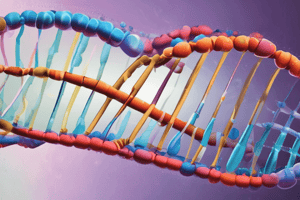Podcast
Questions and Answers
What role does DNA polymerase I play in DNA replication?
What role does DNA polymerase I play in DNA replication?
- It seals the gaps between okazaki fragments.
- It synthesizes new RNA primers.
- It removes RNA primers and replaces them with DNA. (correct)
- It acts as a proofreading enzyme for both strands.
What is the function of the 3’ to 5’ exonuclease activity of DNA polymerases?
What is the function of the 3’ to 5’ exonuclease activity of DNA polymerases?
- It synthesizes new RNA primers.
- It removes the RNA primer from the newly formed DNA.
- It facilitates the joining of okazaki fragments.
- It proofreads and corrects errors during DNA synthesis. (correct)
How are okazaki fragments connected during DNA replication?
How are okazaki fragments connected during DNA replication?
- By DNA polymerase III.
- By the formation of phosphodiester bonds by DNA ligase. (correct)
- By transient hydrogen bonds.
- By ligating RNA primers.
During the replication process, what leads to the possibility of mutations?
During the replication process, what leads to the possibility of mutations?
What is the correct order of actions taken by DNA polymerase I during replication?
What is the correct order of actions taken by DNA polymerase I during replication?
What is the role of specific initiation proteins in DNA replication?
What is the role of specific initiation proteins in DNA replication?
What is the significance of RNA primer in DNA replication?
What is the significance of RNA primer in DNA replication?
In which direction does DNA polymerase III add nucleotides during DNA synthesis?
In which direction does DNA polymerase III add nucleotides during DNA synthesis?
What characterizes the leading strand during DNA replication?
What characterizes the leading strand during DNA replication?
What distinguishes Okazaki fragments in DNA replication?
What distinguishes Okazaki fragments in DNA replication?
Which enzyme is responsible for sealing the gaps formed after RNA primers are removed?
Which enzyme is responsible for sealing the gaps formed after RNA primers are removed?
What is the function of unwinding proteins in DNA replication?
What is the function of unwinding proteins in DNA replication?
How does the activity of DNA polymerase III differ on the leading and lagging strands?
How does the activity of DNA polymerase III differ on the leading and lagging strands?
Flashcards
DNA Replication Errors
DNA Replication Errors
Errors during DNA replication can lead to mutations.
DNA Proofreading
DNA Proofreading
DNA polymerase I and III check the new DNA for mistakes and fix them.
Okazaki Fragments
Okazaki Fragments
Short DNA segments created during lagging strand synthesis.
RNA Primer Removal
RNA Primer Removal
Signup and view all the flashcards
Fragment Joining
Fragment Joining
Signup and view all the flashcards
DNA replication initiation point
DNA replication initiation point
Signup and view all the flashcards
Replication fork
Replication fork
Signup and view all the flashcards
Template DNA
Template DNA
Signup and view all the flashcards
RNA primer
RNA primer
Signup and view all the flashcards
Leading strand
Leading strand
Signup and view all the flashcards
Lagging strand
Lagging strand
Signup and view all the flashcards
DNA polymerase III
DNA polymerase III
Signup and view all the flashcards
Study Notes
DNA Replication: A Detailed Overview
- Initiation: Replication begins at specific sites called origins. These origins are 100-200 base pair sequences recognized by initiation proteins. RNA polymerase synthesizes RNA primers which are required to begin DNA chain formation. Prokaryotes usually have one origin, while eukaryotes have multiple.
- Unwinding: DNA unwinding proteins attach to the nicked DNA, separating the double helix.
- Template DNA: The original DNA strand serves as a template for the new strand synthesis.
- RNA Primer: RNA primers are essential for initiating DNA synthesis. Without them, replication is unstable.
- Chain Elongation: DNA polymerase III adds nucleotides in the 5' to 3' direction.
- Replication Forks: The unwinding process creates replication forks (bubbles).
- Okazaki Fragments: The lagging strand is synthesized discontinuously in short fragments (Okazaki fragments). This is because DNA polymerase III can only synthesize in the 5' to 3' direction. The leading strand is synthesized continuously.
- Ligation: RNA primers are removed, and the gaps are sealed by DNA ligase.
- Bidirectional vs. Unidirectional: Replication can occur in one direction (unidirectional) or in both directions (bidirectional) from the origin.
- Proofreading: DNA polymerase I and III have proofreading features (3' to 5' exonuclease activity) to correct errors during replication.
- Primer Removal and Completion: DNA polymerase I removes RNA primers and replaces them with DNA.
- Fragment Joining: DNA ligase creates phosphodiester bonds between Okazaki fragments, completing the lagging strand.
Studying That Suits You
Use AI to generate personalized quizzes and flashcards to suit your learning preferences.




